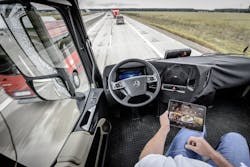It’s not every day that you encounter and analogy that links self-driving vehicle technology and golf clubs. Not by a long shot.
[OK; you knew that was coming – admit it.]
Yet in some ways, this most unusual analogy – offered up by Kathy Winter, vice president and general manager of the automated driving solutions division at Intel Corp. – makes a lot of sense.
“Golf is one of my favorite pastimes and … it takes a certain amount of strategy and creativity to decide which clubs to use along the way,” she explained in a recent blog post – part of a series of posts addressing the technical issues surrounding autonomous vehicles (AVs).
In terms of golf club selection, Winter noted that some are “fairly obvious,” such as using a driver off the tee, a wedge for the sand trap or a putter for the green.
Other shots, however, require a bit more ingenuity when it comes to club selection – such as using a 3-iron to “punch out” from under a tree.
“I like to think of my bag of clubs as my golfing toolkit – each club chosen to provide optimal performance and power for the circumstances,” Winter noted.
And just as one needs different clubs to successfully play 18 holes of golf, she emphasized, different kinds of processors tare needed to successfully “drive” an autonomous vehicle.
Take sensors as an example. Each type of sensor generates a very different kind of data: cameras generate pixels; LIDAR, short for “light detection and ranging,” uses light in the form of a pulsed laser to measure “ranges” variable distances; and radar generates analog waveforms.
“All of these data types need to be processed differently,” Winter pointed out. “And if you were developing an autonomous car brain, you would choose very specialized tools perfectly suited to each data type rather than a single gaming processor for all of it.”
The same “golf club” philosophy, if you will, holds true for the “artificial intelligence” or AI inside a self-driving vehicle as well, she stressed.
“We often hear that the role of AI in autonomous cars is for ‘computer vision,’ and that a specific kind of computing element can be used for all AI in autonomous driving,” Winter said. “But that’s an incomplete picture of the challenge.”
She explained that AI is much more than computer vision; in fact, it’s used throughout a driverless vehicle to do everything from natural language processing and “personalization” to decision-making.
“Those are all very different kinds of AI, each with very different and unique computing needs,” Winter emphasized. “So instead of choosing one processor for all of the artificial intelligence tasks in the car, you need a processing toolkit with computing elements designed for each of those very different tasks.”
Thus, in similar fashion as to how golfers need a full bag of clubs to successfully play golf, AV designers need a suite of computing technologies to successfully engineer an AV’s “brain” and all the different functions it needs to control and perform.
“Although golf gives us an interesting way to describe the complexity of autonomous car design, I have to end my analogy there,” Winter stressed.
“Golf is a fun game … but a game nonetheless. Autonomous driving is not; we also know exactly how challenging it is,” she pointed out. “If you ask the leaders in autonomous driving what kind of computer they would design for deployment in [self-driving] cars five years from now, none of them can tell you. The rate of change and innovation in this industry is staggering.”
Something to keep in mind as efforts to deploy autonomous cars and trucks on our roads continue to gain speed.





